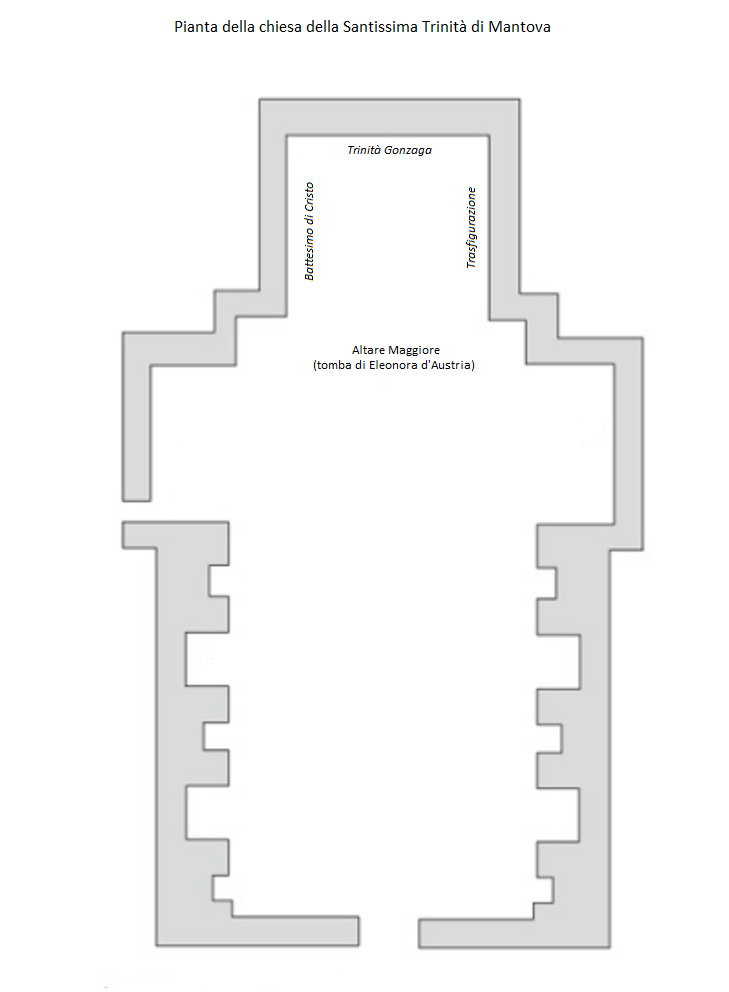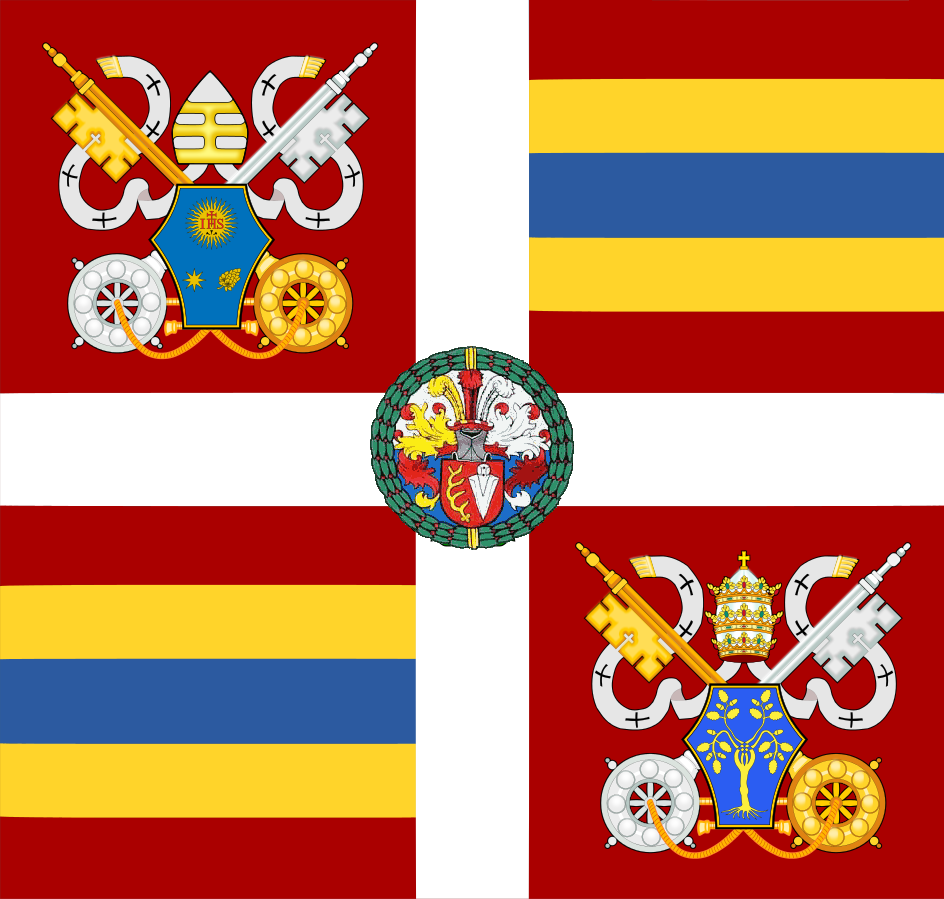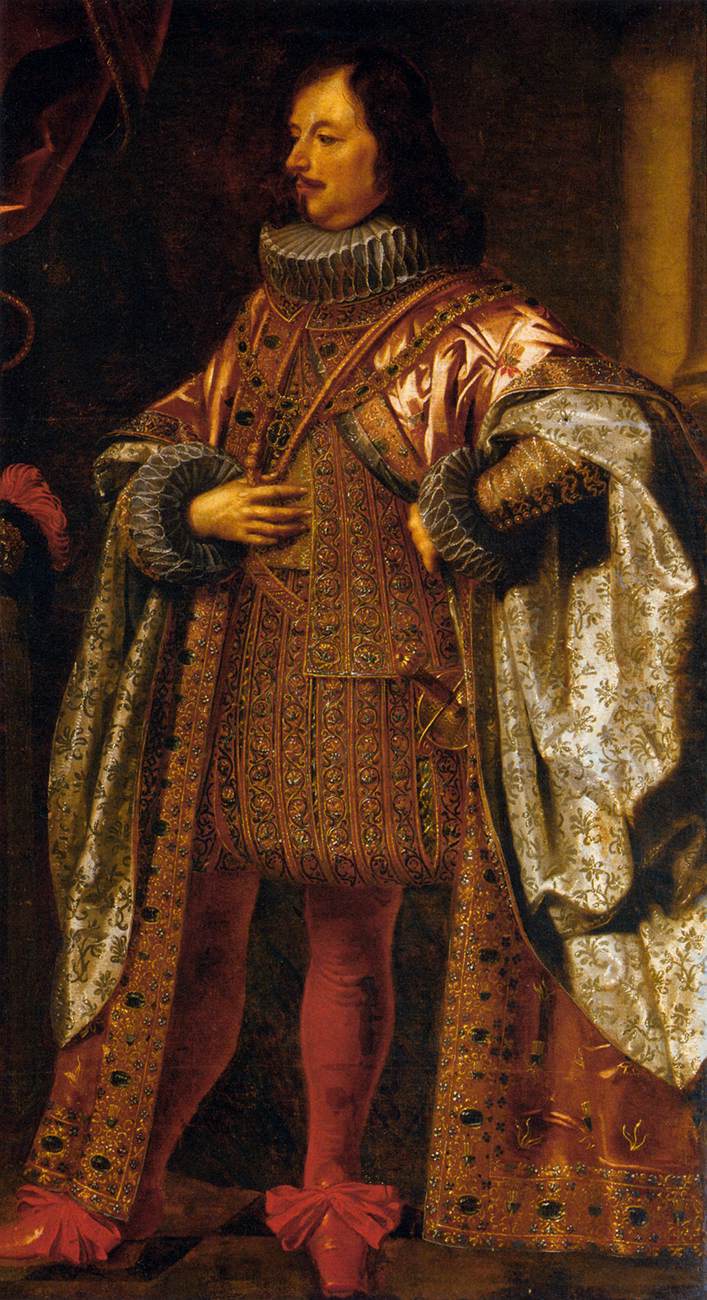|
Gonzaga Family In Adoration Of The Holy Trinity
''The Gonzaga Family in Adoration of the Holy Trinity'' (also, ''The Trinity Adored by the Gonzaga Family'' or ''The Gonzaga Trinity'') is a painting by the Flemish artist Peter Paul Rubens, housed in the Ducal Palace in Mantua, Italy. The work was commissioned by Duke Vincenzo I Gonzaga for the Jesuit church in Mantua, while Rubens was his court painter. The work represents the central part of a triptych, of which the two side panels were the '' Transfiguration'' and the ''Baptism of Christ''. During the 19th-century French occupation of northern Italy in the Napoleonic Wars, the work was split, and some portions were lost. The canvas portrays Vincenzo I and his wife Eleonora de' Medici near images of the duke's parents, Guglielmo Gonzaga and Eleonore of Austria. Also depicted are several of their children with some halberdiers, one of whom is Rubens's self-portrait. History The painting was commissioned by Duke Vincenzo I Gonzaga as the culminating work of a large cycle ... [...More Info...] [...Related Items...] OR: [Wikipedia] [Google] [Baidu] |
Peter Paul Rubens
Sir Peter Paul Rubens (; ; 28 June 1577 – 30 May 1640) was a Flemish artist and diplomat from the Duchy of Brabant in the Southern Netherlands (modern-day Belgium). He is considered the most influential artist of the Flemish Baroque tradition. Rubens's highly charged compositions reference erudite aspects of classical and Christian history. His unique and immensely popular Baroque style emphasized movement, colour, and sensuality, which followed the immediate, dramatic artistic style promoted in the Counter-Reformation. Rubens was a painter producing altarpieces, portraits, landscapes, and history paintings of mythological and allegorical subjects. He was also a prolific designer of cartoons for the Flemish tapestry workshops and of frontispieces for the publishers in Antwerp. In addition to running a large workshop in Antwerp that produced paintings popular with nobility and art collectors throughout Europe, Rubens was a classically educated humanist scholar and diploma ... [...More Info...] [...Related Items...] OR: [Wikipedia] [Google] [Baidu] |
Napoleonic Looting
The Napoleonic looting of art (french: Spoliations napoléoniennes) was a series of confiscations of artworks and precious objects carried out by the French army or French officials in the conquered territories of the French Republic and Empire, including the Italian peninsula, Spain, Portugal, the Low Countries, and Central Europe. The looting began around 1794 and continued through Napoleon's rule of France, until the Congress of Vienna in 1815 ordered the restitution of the works. During the Napoleonic era, an unknown but immense quantity of art was acquired, destroyed, or lost through treaties, public auctions, and unsanctioned seizures. Coins and objects made of precious metals, such as the '' Jewel of Vicenza'' and the bucentaur, the Venetian state barge, were melted down for easier sale and transport, to finance French military wages. In the confusion, many artworks and manuscripts were lost in transit or broken into pieces, which were often never reunited, as occurred wit ... [...More Info...] [...Related Items...] OR: [Wikipedia] [Google] [Baidu] |
Philip II Of Spain
Philip II) in Spain, while in Portugal and his Italian kingdoms he ruled as Philip I ( pt, Filipe I). (21 May 152713 September 1598), also known as Philip the Prudent ( es, Felipe el Prudente), was King of Spain from 1556, King of Portugal from 1580, and King of Naples and Sicily from 1554 until his death in 1598. He was '' jure uxoris'' King of England and Ireland from his marriage to Queen Mary I in 1554 until her death in 1558. He was also Duke of Milan from 1540. From 1555, he was Lord of the Seventeen Provinces of the Netherlands. The son of Emperor Charles V and Isabella of Portugal, Philip inherited his father's Spanish Empire in 1556 and succeeded to the Portuguese throne in 1580 following a dynastic crisis. The Spanish conquests of the Inca Empire and of the Philippines, named in his honor by Ruy López de Villalobos, were completed during his reign. Under Philip II, Spain reached the height of its influence and power, sometimes called the Spanish Golden Age, and r ... [...More Info...] [...Related Items...] OR: [Wikipedia] [Google] [Baidu] |
Carlo V
Charles V, french: Charles Quint, it, Carlo V, nl, Karel V, ca, Carles V, la, Carolus V (24 February 1500 – 21 September 1558) was Holy Roman Emperor and Archduke of Austria from 1519 to 1556, King of Spain (Crown of Castile, Castile and Crown of Aragon, Aragon) from 1516 to 1556, and Lord of the Netherlands as titular Duke of Burgundy from 1506 to 1555. He was heir to and then head of the rising House of Habsburg during the first half of the 16th century, his dominions in Europe included the Holy Roman Empire, extending from Kingdom of Germany, Germany to Kingdom of Italy (Holy Roman Empire), northern Italy with direct rule over the Austrian hereditary lands and the Burgundian Low Countries, and Habsburg Spain, Spain with its southern Italy, southern Italian possessions of Kingdom of Naples, Naples, Kingdom of Sicily, Sicily, and Kingdom of Sardinia, Sardinia. He oversaw both the continuation of the long-lasting Spanish colonization of the Americas and the short-live ... [...More Info...] [...Related Items...] OR: [Wikipedia] [Google] [Baidu] |
El Escorial
El Escorial, or the Royal Site of San Lorenzo de El Escorial ( es, Monasterio y Sitio de El Escorial en Madrid), or Monasterio del Escorial (), is a historical residence of the King of Spain located in the town of San Lorenzo de El Escorial, up the valley ( road distance) from the town of El Escorial and about northwest of the Spanish capital Madrid. Built between 1563 and 1584 by order of King Philip II (who reigned 1556–1598), El Escorial is the largest Renaissance building in the world. It is one of the Spanish royal sites and functions as a monastery, basilica, royal palace, pantheon, library, museum, university, school, and hospital. El Escorial consists of two architectural complexes of great historical and cultural significance: the royal monastery itself and '' La Granjilla de La Fresneda'', a royal hunting lodge and monastic retreat about 5 kilometres away. These sites have a dual nature: during the 16th and 17th centuries, they were places in which the power of th ... [...More Info...] [...Related Items...] OR: [Wikipedia] [Google] [Baidu] |
Pompeo Leoni
:''For the early 17th-century composer, see Leone Leoni (composer)''. Leone Leoni (ca. 1509 – 22 July 1590) was an Italian sculptor of international outlook who travelled in Italy, Germany, Austria, France, Spain and the Netherlands. Leoni is regarded as the finest of the ''Cinquecento'' medallists. He made his reputation in commissions he received from the Habsburg monarchs Charles V, Holy Roman Emperor and Philip II of Spain. His usual medium was bronze, although he also worked in marble and alabaster, carved gemstones and probably left some finished work in wax (in which many of his sculptures were modelled), as well as designing coins. He mainly produced portraits, and was repeatedly used by the Spanish, and also the Austrian, Habsburgs. Biography His family origins were at Arezzo, though he was probably born at Menaggio near Lake Como, and his early training, to judge from the finish of his medals, was with a medallist or goldsmith, as Vasari says. His earliest docu ... [...More Info...] [...Related Items...] OR: [Wikipedia] [Google] [Baidu] |
Leone Leoni
:''For the early 17th-century composer, see Leone Leoni (composer)''. Leone Leoni (ca. 1509 – 22 July 1590) was an Italian sculptor of international outlook who travelled in Italy, Germany, Austria, France, Spain and the Netherlands. Leoni is regarded as the finest of the ''Cinquecento'' medallists. He made his reputation in commissions he received from the Habsburg monarchs Charles V, Holy Roman Emperor and Philip II of Spain. His usual medium was bronze, although he also worked in marble and alabaster, carved gemstones and probably left some finished work in wax (in which many of his sculptures were modelled), as well as designing coins. He mainly produced portraits, and was repeatedly used by the Spanish, and also the Austrian, Habsburgs. Biography His family origins were at Arezzo, though he was probably born at Menaggio near Lake Como, and his early training, to judge from the finish of his medals, was with a medallist or goldsmith, as Vasari says. His earliest documenta ... [...More Info...] [...Related Items...] OR: [Wikipedia] [Google] [Baidu] |
Swiss Guard
The Pontifical Swiss Guard (also Papal Swiss Guard or simply Swiss Guard; la, Pontificia Cohors Helvetica; it, Guardia Svizzera Pontificia; german: Päpstliche Schweizergarde; french: Garde suisse pontificale; rm, Guardia svizra papala) is an armed force and honour guard unit maintained by the Holy See that protects the Pope and the Apostolic Palace within the territory of the Vatican City. Established in 1506 under Pope Julius II, the Pontifical Swiss Guard is among the oldest military units in continuous operation. The dress uniform is of blue, red, orange and yellow with a distinctly Renaissance appearance. The Swiss Guard are equipped with traditional weapons, such as the halberd, as well as with modern firearms. Since the assassination attempt on Pope John Paul II in 1981, a much stronger emphasis has been placed on the Guard's non-ceremonial roles, and has seen enhanced training in unarmed combat and small arms. Recruits to the guards must be unmarried Swiss Cathol ... [...More Info...] [...Related Items...] OR: [Wikipedia] [Google] [Baidu] |
Eleonora Gonzaga (1598–1655)
Eleonora Gonzaga (23 September 1598 – 27 June 1655), was born a Princess of Mantua as a member of the House of Gonzaga, and by marriage to Ferdinand II, Holy Roman Emperor, was Holy Roman Empress, German Queen, Queen of Hungary and Bohemia. Nicknamed the Elder (german: Ältere) to distinguish herself from her namesake great-niece, during her tenure, the Imperial court in Vienna became one of the centers of European Baroque music. As Empress, Eleanora was a supporter of the Counter-Reformation. Life Early years Eleonora was born in Mantua on 23 September 1598,Semenov 2002, p. 198. as the youngest child of Vincenzo Gonzaga, Duke of Mantua and Monferrato, and his wife and first cousin Eleonora de' Medici. On her father's side her grandparents were Guglielmo Gonzaga, Duke of Mantua and Montferrato and his wife Archduchess Eleanor of Austria, and on her mother's side her grandparents were Francesco I de' Medici, Grand Duke of Tuscany and his first wife Archduchess Jo ... [...More Info...] [...Related Items...] OR: [Wikipedia] [Google] [Baidu] |
Margherita Gonzaga, Duchess Of Lorraine
Margherita Gonzaga (2 October 1591 – 7 February 1632) was Duchess of Lorraine from 1606 until 1624 by marriage to Henry II, Duke of Lorraine. She was an agent of Pro-French and anti Protestant policy in Lorraine, and are most known for her support of her daughter Nicole's right to the Duchy of Lorraine. She also claimed her right to Monferrato during the Mantuan war of succession. Life She was born in Mantua, the eldest daughter of Vincenzo I Gonzaga and Eleonora de' Medici; she was also a sister of Francesco IV Gonzaga, Ferdinando I Gonzaga, Vincenzo II Gonzaga and Eleonora Gonzaga. Her brothers all succeeded their father as Duke of Mantua and Eleonora became Holy Roman Empress by her marriage to Ferdinand II, Holy Roman Emperor. Marriage She married Henry II, Duke of Lorraine on 24 April 1606. He had previously been married to Catherine of Navarre, sister of King Henry IV of France, but the marriage was childless (Catherine was forty years old at the time of her marriage) ... [...More Info...] [...Related Items...] OR: [Wikipedia] [Google] [Baidu] |
Vincenzo II Gonzaga
Vincenzo II Gonzaga (7 January 1594 – 25 December 1627) was Duke of Mantua and Duke of Montferrat from 1626 until his death. Vincenzo was the son of Duke Vincent I and Eleonora de' Medici and inherited the duchy upon the death of his elder brother Ferdinand, receiving the imperial investiture on 8 February 1627. He had also received a cardinalate upon Ferdinando's succession, but had dismissed it in 1616 in order to marry his relative Isabella Gonzaga, daughter of Alfonso Gonzaga, Count of Novellara. Conscious of his poor health, the childless Vincenzo set up an inheritance for his lands through the marriage of his niece Maria (daughter of the former Duke Francis IV) with Charles of Nevers' son Charles of Gonzaga-Nevers. The elder Charles was a cousin of his father. Vincenzo died on the marriage day of Mary and Charles. Family Vincenzo II Gonzaga had no legitimate offspring from the wife, but he recognized four natural sons. By Paola Scarpelli: * Federico Gonzaga (161 ... [...More Info...] [...Related Items...] OR: [Wikipedia] [Google] [Baidu] |
Ferdinando Gonzaga
Ferrante I Gonzaga (also Ferdinando I Gonzaga; 28 January 1507 – 15 November 1557) was an Italian condottiero, a member of the House of Gonzaga and the founder of the branch of the Gonzaga of Guastalla. Biography He was born in Mantua, the third son of Francesco II Gonzaga and Isabella d'Este. At the age of sixteen he was sent to the court of Spain as a page to the future emperor Charles V, to whom Ferrante remained faithful for his whole life. In 1527 he took part in the Sack of Rome and attended Charles' triumphant coronation at Bologna in 1530: at the death of Charles of Bourbon (1527) he was appointed commander-in-chief of the Imperial army in Italy. He became a Knight in the Order of the Golden Fleece in 1531. He defended Naples from the assault of the French troops under Odet of Foix, Viscount of Lautrec, and obtained the surrender of the Republic of Florence. For this feat Pope Clement VII, a member of the Medici who had been ousted from that city, named him papal g ... [...More Info...] [...Related Items...] OR: [Wikipedia] [Google] [Baidu] |


.png)


%2C_1541%2C_NGA_45097.jpg)



.jpg)